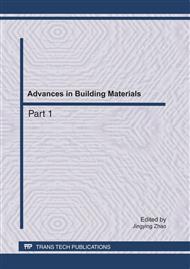[1]
Been, K., Jeferies, M.G., 1985. A state parameter for sands. Geotechnique 35(2), 99–112.
Google Scholar
[2]
Jefferies, M.G.,1993. Nor-Sand: a simple critical state for sand. Geotechnique 43(1), 91–103.
Google Scholar
[3]
Muir Wood, D., Belkheiasr, K., Liu, D.F., 1994. Strain softening and state parameter for sand modeling. Geotechnique 44 (2), 335–339.
Google Scholar
[4]
Manzari, M.T., Dafalias, Y.F., 1997. A critical state two-surface plasticity model for sands. Geotechnique 47(2), 255–272.
DOI: 10.1680/geot.1997.47.2.255
Google Scholar
[5]
Li, X.S., Dafalias, Y.F., Wang, Z.L., 1999. State-dependent dilatancy in critical-state constitutive modeling of sand. Canadian Geotechnical Journal 36, 599–611.
DOI: 10.1139/t99-029
Google Scholar
[6]
Li, X.S., Dafalias, Y.F., 2000. Dilatancy for cohesionless soils. Geotechnique 50(4),449–460.
DOI: 10.1680/geot.2000.50.4.449
Google Scholar
[7]
Li, X.S., 2002. A sand model with state-dependent dilatancy. Geotechnique 52(3), 173–186.
Google Scholar
[8]
Wan, R.G., Guo, P.J., 1999. A pressure and density dependent dilatancy model for granular materials. Soils and Foundations 39(6), 1–12.
DOI: 10.3208/sandf.39.6_1
Google Scholar
[9]
Gajo, A., Muir Wood, D., 1999a. Severn-Trent sand: a kinematic-hardening constitutive model: the q-p formulation. Geotechnique 49(5), 595–614.
DOI: 10.1680/geot.1999.49.5.595
Google Scholar
[10]
Gajo, A., Muir Wood, D., 1999b. A kinematic hardening constitutive model for sands: the multiaxial formulation. International Journal for Numerical and Analytical Methods in Geomechanics 23, 925–965.
DOI: 10.1002/(sici)1096-9853(19990810)23:9<925::aid-nag19>3.0.co;2-m
Google Scholar
[11]
Pietruszczak, S., Stolle, D., 1987. Modelling of sand behavior under earthquake excitation. International Journal for Numerial and Analytical Method in Goemechanics 11, 221–240.
DOI: 10.1002/nag.1610110302
Google Scholar
[12]
Richart, F.E., Jr Hall, J.R., Woods, R.D., 1970. Vibrations of soils and foundations. Prentice-Hall , Englewood Cliffs.
Google Scholar
[13]
QIAN, J.G., HUANG, M.S., YANG, J., 2006. Effect of non-coaxial plasticity on onset strain localization in soils under 3D stress condition. Chinese Journal of Geotechnical Engineering 28(4), 510–515,in Chinese.
Google Scholar
[14]
Desrues, J., Hammad, W., 1989. Shear band dependency on mean stress level in sand. Dembicki E, Gudehus G, Sikora Z. (Eds.), 2nd International Workshop on Numerical Methods for Localization and Bifurcation of Granular Bodies. Technical University of Gdansk: Gdansk, Poland, p.57–67.
Google Scholar


